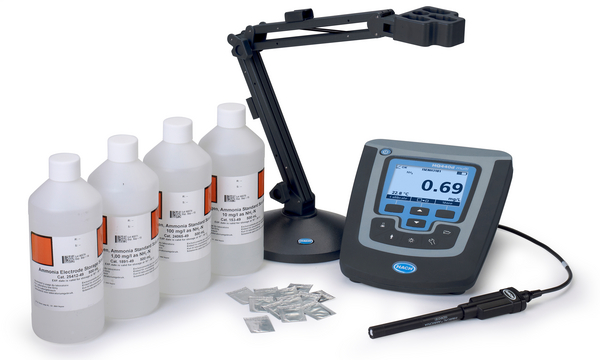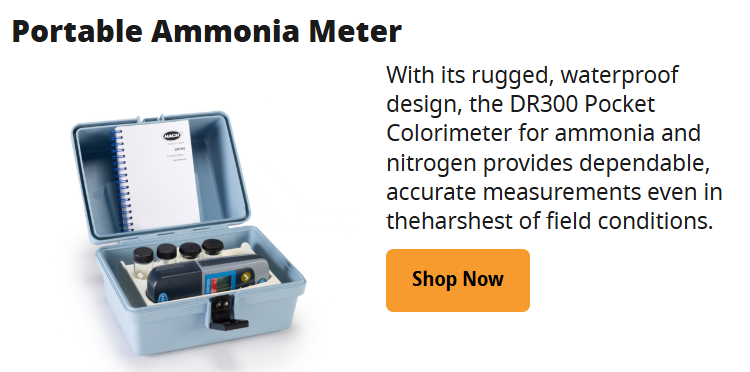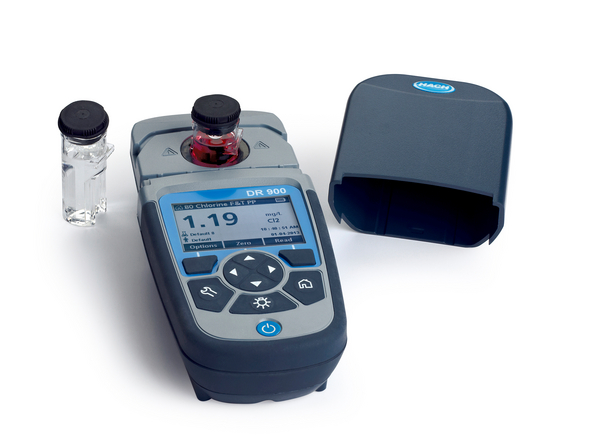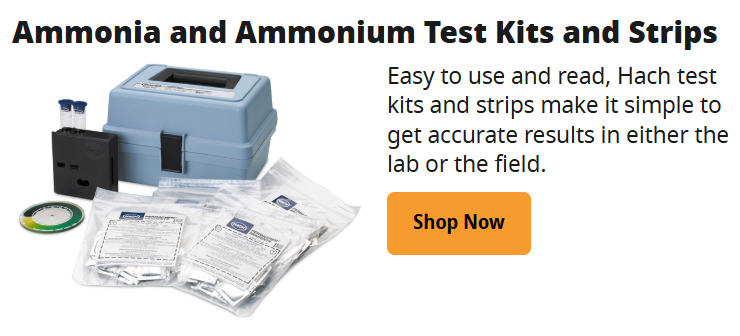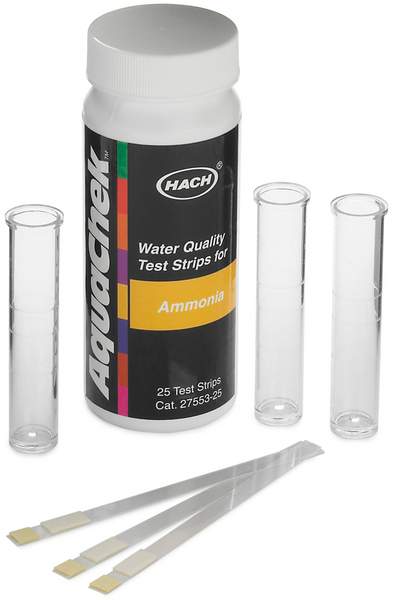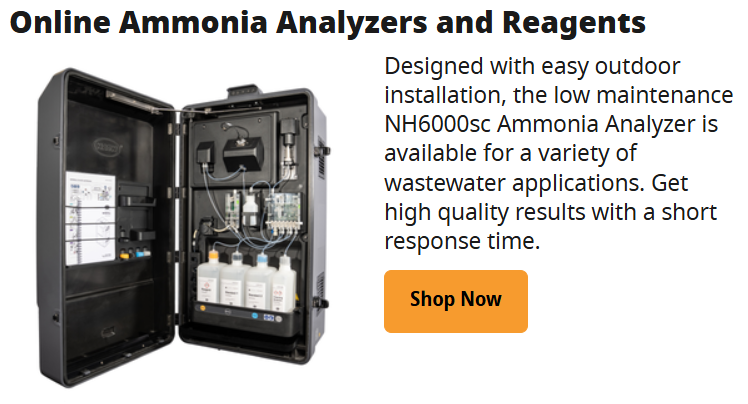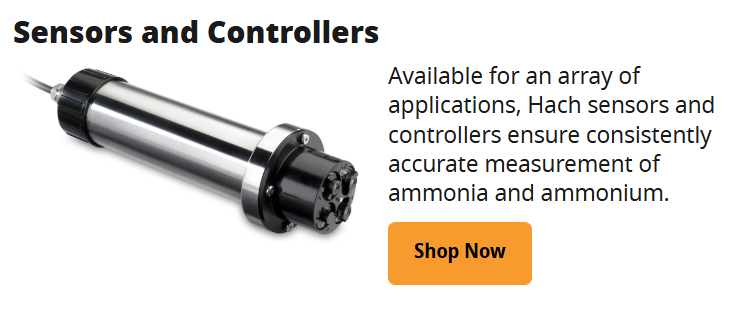水中氨氮與分析

What’s the difference between ammonia and ammonium ? 氨和銨
Ammonia and ammonium are both compounds that contain hydrogen and nitrogen. Ammonia has one nitrogen atom and three hydrogen atoms (NH3), and ammonium has one nitrogen atom and four hydrogen atoms (NH4).
This small difference in hydrogen makes a big difference in the compounds. While ammonia has a pungent smell and can be harmful to aquatic organisms, ammonium is both odorless and harmless.
Due to the various potential risks of excessive ammonia in water, it is important to have dependable, simple ammonia testing solutions. Despite its relative harmless, ammonium also needs to be accurately monitored in order to have a thorough understanding of water quality in lakes, rivers and water treatment facilities.
Hach® offers a variety of ammonia analyzers, test kits, reagents and more to help you easily and accurately measure ammonia and ammonium in a variety of applications.
This small difference in hydrogen makes a big difference in the compounds. While ammonia has a pungent smell and can be harmful to aquatic organisms, ammonium is both odorless and harmless.
Due to the various potential risks of excessive ammonia in water, it is important to have dependable, simple ammonia testing solutions. Despite its relative harmless, ammonium also needs to be accurately monitored in order to have a thorough understanding of water quality in lakes, rivers and water treatment facilities.
Hach® offers a variety of ammonia analyzers, test kits, reagents and more to help you easily and accurately measure ammonia and ammonium in a variety of applications.
氨和銨都是含有氫和氮的化合物。氨有一個氮原子和三個氫原子(NH3),銨有一個氮原子和四個氫原子(NH4)。
微小差異的氫為化合物帶來很大的不同。氨具有刺鼻的氣味並且可能對水生生物有害,而銨則無味且無害。
水中過量的氨有著各種潛在風險,因此擁有可靠、簡單的氨測試方案非常重要。儘管銨相對無害,但為了徹底了解湖泊、河流和水處理設施的水質,所以也需要對銨進行準確監測。
Hach提供各種手持式/實驗室/線上氨分析儀、簡易測試套組、試劑試紙等,協助您在各種應用中輕鬆並準確地測量氨和銨濃度。
Why Monitor and Measure Ammonia 為什麼要測量水中氨濃度 ?
Ammonia is used as both a reagent and as a measurement parameter in several areas of water and wastewater treatment. 在水和廢水處理的多個領域中,氨既作為試劑,也作為測量參數。
Ammonia is used as both a reagent and as a measurement parameter in several areas of water and wastewater treatment. 在水和廢水處理的多個領域中,氨既作為試劑,也作為測量參數。
- Naturally occurring ammonia is monitored in source water. 在源水中監測天然存在的氨
- During the chloramination disinfection process, ammonia is combined with chlorine to treat drinking water and maintain a longer-lasting residual in distribution systems. 在氯胺消毒過程中,氨與氯結合處理自來水,並在配水系統中保持更持久的殘留
- Sometimes ammonia is used for pH control, such as in the pharmaceutical industry. 有時也會使用氨來控制 pH 值,例如在製藥產業
- Ammonia is widely monitored in wastewater nitrification and denitrification processes. 氨在廢污水硝化和反硝化過程中被廣泛的監測
While generally harmless at low concentrations, high concentrations of ammonia can cause damage and pose health risks. Therefore, ammonia levels must be properly monitored and maintained. 雖然低濃度的氨通常無害,但是高濃度的氨會造成損害並造成健康風險。因此,必須適當監測和維持氨的濃度。
At Hach®, find the testing equipment, resources, training and software you need to successfully monitor and manage ammonia levels in your specific process application.
Which Processes Require Ammonia Monitoring 哪些程序需要監測水中氨濃度 ?
Drinking Water Treatment 飲用水(自來水)
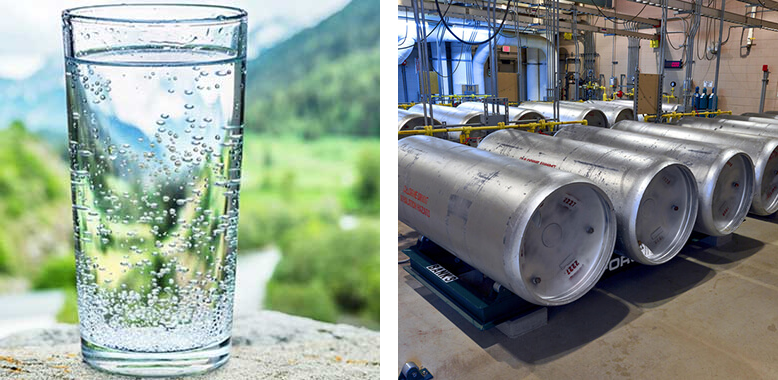
Gaseous ammonia and its concentrated solutions must be handled with care and in accordance with OSHA (or other relevant regulatory agency’s) requirements. This is due to highly corrosive properties that pose serious health risks ranging from mild eye or skin irritation to chemical burning, depending on the concentration. Additionally, off-gassing ammonia can cause aesthetic problems like objectionable taste or odor.
When ammonia is not used for disinfection, its presence in a distribution system may indicate leaching from materials used in the pipework construction or water contamination, due to damage in the system. When unwanted ammonia combines with chlorine, it diminishes the disinfection strength of chlorination.
In some disinfection processes, ammonia is intentionally combined with chlorine to produce monochloramine. Though free chorine is a more powerful disinfectant, monochloramine (bonded ammonia and chlorine) has a stronger residual so it remains in the distribution system longer, thus ensuring disinfection is maintained all the way to the tap. Furthermore, chloramines react less intensely with various impurities in raw water, particularly organic substances, thus minimizing the formation of some carcinogenic disinfection by-products (DBP). To optimize the chloramination process, it is important to monitor the formation of the target disinfectant species, while preventing the formation of less desirable dichloramine or trichloramine (nitrogen trichloride). Monochloramine testing is used together with a free ammonia determination to ensure formation of the right disinfectant and reduce raw material costs by preventing the overfeeding of chlorine and/or ammonia.
Learn more about chloramination.
Free Ammonia
Ammonia that has not bonded with chlorine during chloramination disinfection is referred to as free ammonia (both NH4+ and NH3). At a neutral pH and ambient temperature, almost all free ammonia exists as NH4+. As the pH and temperature increase, the amount of NH3 increases and the amount of NH4+ decreases. When chloraminated water is released, free ammonia levels increase as monochloramine reacts with various organics and bacteria in the distribution system water, satisfying the chlorine demand. Increased free ammonia levels indicate the onset of nitrification. A sudden drop in free ammonia suggests that nitrification is in process and nitrite is being formed. The free ammonia value is useful in determining the amount of free chlorine needed to increase the monochloramine residual at a booster station. The free ammonia level can be reduced by adding free chlorine at a ratio of 5:1 as Cl2:N to guide the process and help minimize nitrification potential.
Ammonia that has not bonded with chlorine during chloramination disinfection is referred to as free ammonia (both NH4+ and NH3). At a neutral pH and ambient temperature, almost all free ammonia exists as NH4+. As the pH and temperature increase, the amount of NH3 increases and the amount of NH4+ decreases. When chloraminated water is released, free ammonia levels increase as monochloramine reacts with various organics and bacteria in the distribution system water, satisfying the chlorine demand. Increased free ammonia levels indicate the onset of nitrification. A sudden drop in free ammonia suggests that nitrification is in process and nitrite is being formed. The free ammonia value is useful in determining the amount of free chlorine needed to increase the monochloramine residual at a booster station. The free ammonia level can be reduced by adding free chlorine at a ratio of 5:1 as Cl2:N to guide the process and help minimize nitrification potential.
Total Ammonia
Total ammonia is the sum of all ammonia nitrogen present in the form of monochloramine (NH2Cl), other chloramines, ammonium ion (NH4+), and molecular ammonia (NH3). This parameter may serve as a primary or secondary verification to maintain the chloramination process under control.
Total ammonia is the sum of all ammonia nitrogen present in the form of monochloramine (NH2Cl), other chloramines, ammonium ion (NH4+), and molecular ammonia (NH3). This parameter may serve as a primary or secondary verification to maintain the chloramination process under control.
Surface/Groundwater Treatment 地面水/地下水

Ammonia is formed as a by-product when bacteria breaks down natural materials in the soil. High ammonia concentrations can be caused by iron-rich soil, proximity to a forest or fertilizer and fecal contamination.
Wastewater Treatment 廢污水處理
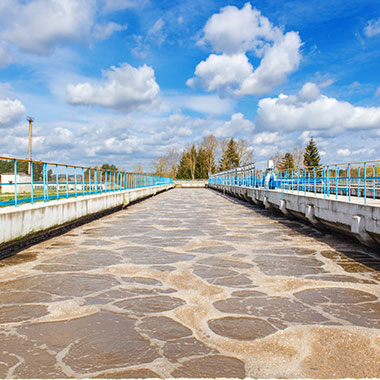
During wastewater treatment, ammonia levels can reach extremely high concentrations as a result of bacterial action. Ammonia is first converted to nitrate through the nitrification process so that it can be reduced to atmospheric nitrogen (N2) by denitrification. Learn more about municipal wastewater treatment. At high concentrations and pH, ammonia can be toxic to sludge digestion microbes. Furthermore, to prevent damage to aquatic life, it is crucial to monitor and remove ammonia from wastewater effluent before it is released into natural bodies of water.
Aquaculture 水產養殖

As a waste product of aquatic life, ammonia can be toxic to fish and aquatic plants at levels as low as 0.5 mg/L. In established aquariums, ammonia can be rapidly converted to nitrite and eventually nitrate. Most aquariums aim to have zero ammonia present.
In natural aquatic environments, high ammonia levels can result in excess algae growth that blocks sunlight, impairing sight-feeding and photosynthesis.
Agriculture 農業

Because plants cannot fix nitrogen directly from the atmosphere, they rely on nitrogen-fixing bacteria to convert nitrogen into ammonia. Nitrogen in the form of ammonia can then be used by plants to create other essential organic molecules needed by complex organisms. To aid or enhance this natural process (which is part of the nitrogen cycle), ammonia is often added to fertilizers. For example, hydroponic nutrient solutions introduce nitrogen as an ammonia salt. Ammonia can also be present in soil due to urea dosing and its sequential decomposition.
Pharmaceutical Manufacturing 製藥產業

In the pharmaceutical industry, ammonia is used for pH control and its solution is used to regenerate weak ion exchange resins and for pH adjustment.
How is Ammonia Monitored 如何測量水中氨濃度 ?
Salicylate Method 水楊酸鹽方法
The salicylate method is a variation of the well-known phenate method, but it has an advantage of being free from mercury salts and phenol. This method is most useful for low range ammonia nitrogen determinations. Although the procedure involves multiple steps before a final green color is developed, all reagents are contained in convenient powder pillows (salicylate reagent powder pillows and alkaline cyanurate powder pillows) or a combination of powder pillows and TNT vials.
The salicylate method is a variation of the well-known phenate method, but it has an advantage of being free from mercury salts and phenol. This method is most useful for low range ammonia nitrogen determinations. Although the procedure involves multiple steps before a final green color is developed, all reagents are contained in convenient powder pillows (salicylate reagent powder pillows and alkaline cyanurate powder pillows) or a combination of powder pillows and TNT vials.
Ammonia compounds react with hypochlorite to form monochloramine.
The monochloramine then reacts with salicylate to form 5-aminosalicylate.
Oxidation of 5-aminosalicylate is carried out in the presence of a catalyst, nitroprusside (also called nitroferricyanide), which results in the formation of indosalicylate, a blue-colored compound. The blue color is masked by the yellow color (from excess nitroprusside) causing a green-colored solution. The intensity of the resulting green color is directly proportional to the ammonia concentration in the sample.
The monochloramine then reacts with salicylate to form 5-aminosalicylate.
Oxidation of 5-aminosalicylate is carried out in the presence of a catalyst, nitroprusside (also called nitroferricyanide), which results in the formation of indosalicylate, a blue-colored compound. The blue color is masked by the yellow color (from excess nitroprusside) causing a green-colored solution. The intensity of the resulting green color is directly proportional to the ammonia concentration in the sample.
Gas Sensing Probe 氣敏電極方法
The ammonia electrode measures ammonia gas in aqueous solutions, or ammonium ions that have been converted to gas by the addition of a strong base. The electrode is a complete electrochemical cell consisting of a glass pH electrode and a reference electrode. The gas-permeable membrane separates the sample from a thin layer of electrolyte that is pressed between the pH bulb and the membrane. At high pH, ammonium ion is converted to ammonia gas. The gas diffuses through the membrane and causes a pH change in the thin layer of electrolyte. The potential across the pH glass changes as a result of the pH change and the electrode measures the change in potential. The measured pH change is proportional to the ammonia concentration in the solution.
The ammonia electrode measures ammonia gas in aqueous solutions, or ammonium ions that have been converted to gas by the addition of a strong base. The electrode is a complete electrochemical cell consisting of a glass pH electrode and a reference electrode. The gas-permeable membrane separates the sample from a thin layer of electrolyte that is pressed between the pH bulb and the membrane. At high pH, ammonium ion is converted to ammonia gas. The gas diffuses through the membrane and causes a pH change in the thin layer of electrolyte. The potential across the pH glass changes as a result of the pH change and the electrode measures the change in potential. The measured pH change is proportional to the ammonia concentration in the solution.
Nessler Method 納式方法
In this ammonia test, Nessler reagent (K2HgI4) reacts with the ammonia present in the sample (under strongly alkaline conditions) to produce a yellow-colored species. The intensity of the color is in direct proportion to the ammonia concentration.
In this ammonia test, Nessler reagent (K2HgI4) reacts with the ammonia present in the sample (under strongly alkaline conditions) to produce a yellow-colored species. The intensity of the color is in direct proportion to the ammonia concentration.
2K2HgI4 + NH3 + 3KOH → Hg2OINH2 + 7KI + 2H2O


